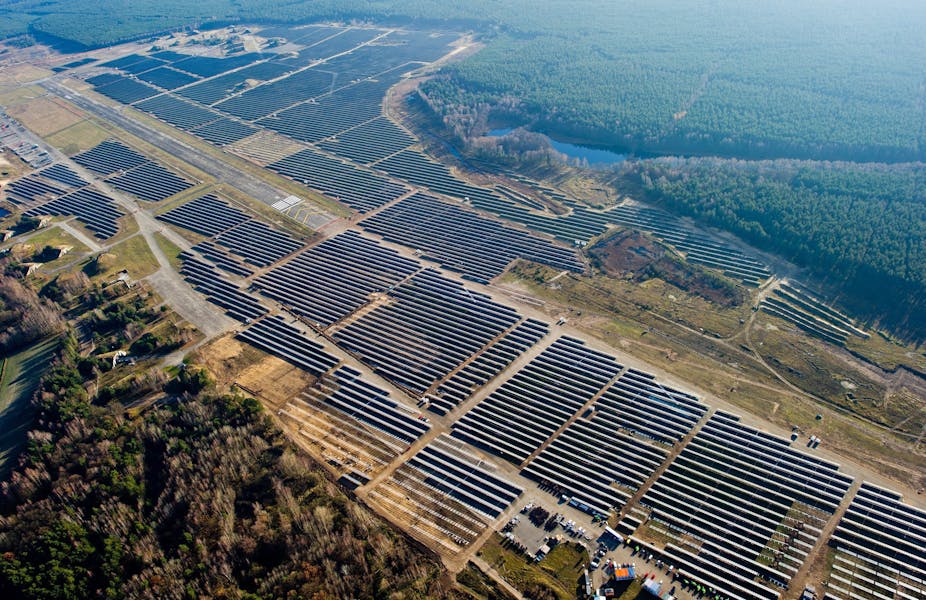A recent report by the Clean Energy Council claims that the capacity of domestic solar panels in Australia has increased 35-fold in the past three years. This (among other factors) means we are well on track to reach our target of having 20% of our national electricity generated from renewable sources by 2020.
If that’s the case, should we now be aiming higher than 20% by 2020? How realistic would such a revised target be? And how would we even get there?
It’s all about solar
Solar electricity is effectively available on an unlimited scale, for an unlimited time with negligible materials or environmental constraints. In fact, the total area of Australian roofs is sufficient to supply all of Australia’s electricity from solar.
The cost of solar power is rapidly decreasing – by a factor of three since 2007. Many energy planners have not yet absorbed the dramatic implications of this seismic shift in energy economics.
The cost of photovoltaic (PV) electricity delivered from house roofs is now well below the retail electricity tariff in Australia, and is half the tariff in Adelaide and Alice Springs. This calculation uses typical installation costs for 2-10 kilowatt (kW) systems ($4,000-4,500 per kW), an interest rate of 7.5% (the current mortgage rate), conservative numbers for annual energy yield, a carbon tax of $25 per tonne, and current renewable energy certificate prices. Future rises in retail tariffs and falls in PV costs will further improve PV economics.
PV costs are also below commercial electricity tariffs. In the near future, there could be a rapid take-up of roof-mounted PV systems at offices, shopping centres, commercial buildings, light industry, educational institutions and the like.
Large scale PV and solar thermal electricity systems can now deliver unsubsidised power for less than 15 cents per kilowatt hour (c/kWh), based on system prices below $3,000 per kW. New wind and gas power stations produce electricity of 8-12 c/kWh. The cost of solar electricity is closing fast on conventional electricity costs.
The PV cost is likely to fall much further before solar technology reaches its limits. At the same time, the cost of wholesale electricity from fossil fuel, is rising due to carbon pricing and rising gas prices.
Coal is so 2009
Few (if any) new coal fired power stations are expected to be built in Australia in the future. Indeed, some coal fired power stations will be retired over the next decade. There is substantial capacity to supplement fossil fuel power stations with heat from solar thermal collectors in order to reduce coal consumption and CO₂ emissions.
New gas-fired power stations are being constructed in Australia but gas prices (and hence electricity prices) might rise substantially. Such a price rise would result from linking domestic and international gas markets, stemming from improved capacity to export gas. As a result, wind and solar power stations could constitute the majority of new capacity in the next decade.
What now?
The factors described above give rise to interesting speculations about future energy markets in Australia. The certainties of the past – of ever-rising demand to be met primarily from coal – are finished.
The rapid rise in electricity tariffs in recent years is driving substantial change in consumer behaviour. PV systems, solar water heaters, efficient lighting, other energy efficiency measures, and a switch to gas, are all causing a reduction in domestic electricity demand.
Electricity distribution companies could be squeezed by rising costs, falling demand and substantial “white-anting” of retail markets by PV. Much of the current capital expenditure is dedicated to meeting peak power demand for a relatively small fraction of the year (for air conditioning on very hot days, for example). The utility companies have not yet seriously engaged in power demand management, through the use of smart meters and time-of-use tariffs, for example.
Some utilities may supress demand for roof-mounted PV by offering very low feed-in tariffs, set at half or less of the retail tariff. This would not take proper account of the value of PV power. That said, such measures are unlikely to prevent rapid commercial take-up of PV, because commercial enterprises use most of their power during daytime and could absorb large amounts of PV power without the need to export to the grid.
In addition, the gap between PV costs and electricity tariffs is now so large that PV owners can afford to install batteries to minimise the need to export power to the grid at unfavourable prices. For large-scale solar power systems, mass storage in the form of pumped hydro and thermal storage in molten salt has the capacity to eliminate the day-night problem of solar.
Long distance DC transmission (Gigawatts at Megavolts over thousands of kilometres) is attractive as it will help minimise the effects of local cloud and seasonal issues. Such power lines are being built around the world.
We’re doing well; now let’s do better
According to the Clean Energy Council report, PV installation rates have risen from about 20 Megawatts (MW) total capacity nationally in 2008 to about 800 Megawatts in 2011. Expected demand will fall in 2012 – perhaps to about 500 MW – because of the end of high feed-in tariffs. But, as mentioned, the economics of PV are now so attractive that long-term, rapidly rising demand is likely.
Putting it into context, we’d need about 3,000 MW of PV to be installed each year to achieve 50% of electricity from PV in 2040 – obviously a feasible proposition given this year’s performance.
As it stands, the Australian target of 20% renewable electricity by 2020 will be easily reached using wind and solar. Much stronger targets should be set: 50% from zero emission technologies by 2030 and 100% by 2050. The costs will be far smaller than hitherto believed, and could even be zero given the demonstrated potential of wind and solar for sustained reductions in costs.

